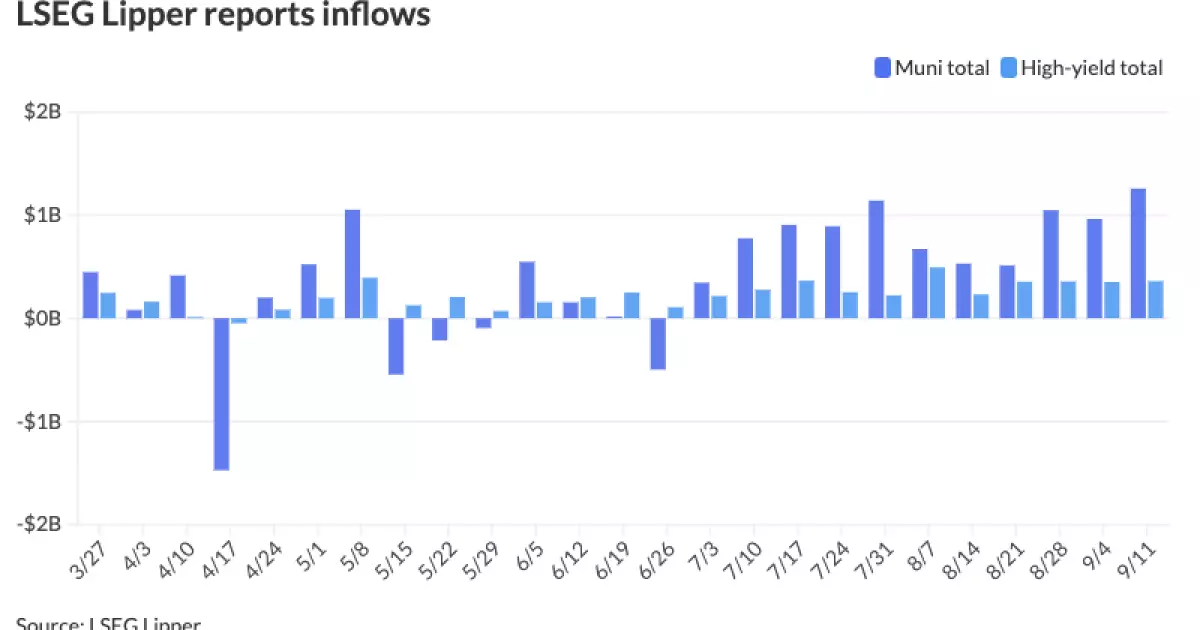The municipal bond market has displayed a noticeable resilience in recent weeks, with minor fluctuations leading to a solid influx of capital into municipal bond mutual funds. Reports indicate that inflows have surpassed $1 billion, marking them as the second largest for the year, a clear signal of strengthened investor confidence in municipal bonds. This influx has been buoyed by a consistent increase in demand, even as U.S. Treasuries exhibit slight weaknesses and equity markets show upward momentum.
According to data provided by LSEG Lipper, investors contributed an impressive $1.258 billion to municipal bond funds, following a substantial $963 million the previous week. This marks the eleventh consecutive week of positive inflows, a clear indication of renewed interest in the municipal bond market. The growing appeal of high-yield investments is also reflected in the significant inflows of $360.2 million reported during the same period.
The recent surge in inflows comes on the heels of an unprecedented period marked by record outflows from municipal bond funds. From the onset of the Federal Reserve’s tightening measures in the first quarter of 2022 through the close of 2023, municipal funds suffered net outflows totaling around $122 billion. This period of withdrawal represented not only the largest but also the longest in municipal market history.
However, as 2023 unfolded, circumstances began to shift. Higher nominal income opportunities drew investors back to municipal assets, signaling a recovery. Recent figures reported by the Investment Company Institute indicated that municipal bond funds and exchange-traded funds amassed a total of $27.3 billion in inflows by early September, signaling a significant rebound. According to Sam Weitzman from Western Asset Management, the demand for long-duration and high-yield funds has been cornerstone to this recovery, with notable inflows of $24 billion and $11 billion, respectively.
Analyzing historical trends, the previous six inflow cycles before 2022 demonstrated healthy returns for municipal bonds, averaging a growth of 12.4%. In stark contrast, the Bloomberg Municipal Bond Index has reflected an average decrease of 2.0% during these tumultuous times. As Weitzman pointed out, the current inflow cycle, while positive, has not yet reached the historical averages that would suggest a complete recovery in investor sentiment towards municipal bonds.
Current inflow data appears subdued when compared to the outflows witnessed in the previous years, hinting that additional growth potential exists as the Federal Reserve navigates its anticipated easing policies. If history is any indicator, these shifts in capital could contribute to both improved municipal valuations and opportunities for investors.
Fundamental analyses suggest that the municipal market is in a better condition than it has been for several years. The ongoing shifts in the two-year municipal-to-Treasury ratios, which stood at 64% on Thursday for instance, point to potentially lucrative entry points for investors. Notably, the ratios for longer-term bonds like the 30-year are currently viewed as offering considerable value in comparison to taxable alternatives.
While market strategists such as those from J.P. Morgan predict that these ratios could soften further as we transition into the fall, they still commend the relative appealing nature of tax-exempt municipal bonds against corporate bonds, which could attract cautious investors seeking stability in a volatile market.
Despite the current upward trajectory, the municipal bond market faces challenges, including increasing supply levels. An uptick in issuance has been observed as municipalities prepare for anticipated electoral pressures in November, prompting issuers to front-load their issuance timelines. With larger deals in the pipeline, market watchers expect the pricing of these bonds may come with greater concessions, which, from an investment perspective, should maintain the attractive yield spread.
Moreover, the ongoing infrastructure challenges faced by many municipalities imply a growing need for capital. As governmental support dwindles, many issuers will inevitably turn to the capital markets to secure the necessary funding for essential projects.
While the municipal bond market has demonstrated considerable resilience against recent economic headwinds, the interplay of supply, demand, and historical trends suggest that cautious optimism is warranted. Investors would do well to keep a watchful eye on market dynamics as the landscape evolves, particularly in response to Federal Reserve policies and the upcoming electoral context. The current situation presents both opportunities and challenges that will shape the municipal bond narrative in the months ahead.

